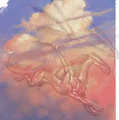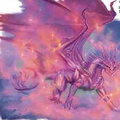Epic Dragon: Difference between revisions
No edit summary |
(Undo revision 800394 by 155.246.161.54 (talk)) |
||
| Line 1: | Line 1: | ||
'''Epic Dragons''' are a small family of dragons first introduced in the [[Epic Level Handbook]]. Epic dragons are much larger and more powerful than other kinds of dragons, so much so that they are in the Huge size category and have the abilities of adult dragons even as wyrmlings. Epic dragons are usually neutral aligned, but are more likely to be other alignments than other dragons.<br><br> | '''Epic Dragons''' are a small family of dragons first introduced in the [[Epic Level Handbook]]. Epic dragons are much larger and more powerful than other kinds of dragons, so much so that they are in the Huge size category and have the abilities of adult dragons even as wyrmlings. Epic dragons are usually neutral aligned, but are more likely to be other alignments than other dragons.<br><br> | ||
=== Force Dragon === | === Force Dragon === | ||
Force dragons have a devastating cone of force for their breath weapon and can also use several force based spell-like abilities and are immune to all force effects (in fact they are notable because they are the '''only''' monster in third edition to have any defense against force effects). As a force dragon ages, they become harder and harder to see. Juveniles have the effect of the ''blur'' spell. Old ones replace this with the effects of the ''displacement'' spell. Great Wyrms are completely invisible and displaced. Force dragons have arrogant personalities and prefer to be left alone. Prismatic dragons and a few gods are the only things they have respect for. | Force dragons have a devastating cone of force for their breath weapon and can also use several force based spell-like abilities and are immune to all force effects (in fact they are notable because they are the '''only''' monster in third edition to have any defense against force effects). As a force dragon ages, they become harder and harder to see. Juveniles have the effect of the ''blur'' spell. Old ones replace this with the effects of the ''displacement'' spell. Great Wyrms are completely invisible and displaced. Force dragons have arrogant personalities and prefer to be left alone. Prismatic dragons and a few gods are the only things they have respect for. | ||
Revision as of 09:22, 10 December 2021
Epic Dragons are a small family of dragons first introduced in the Epic Level Handbook. Epic dragons are much larger and more powerful than other kinds of dragons, so much so that they are in the Huge size category and have the abilities of adult dragons even as wyrmlings. Epic dragons are usually neutral aligned, but are more likely to be other alignments than other dragons.
Force Dragon
Force dragons have a devastating cone of force for their breath weapon and can also use several force based spell-like abilities and are immune to all force effects (in fact they are notable because they are the only monster in third edition to have any defense against force effects). As a force dragon ages, they become harder and harder to see. Juveniles have the effect of the blur spell. Old ones replace this with the effects of the displacement spell. Great Wyrms are completely invisible and displaced. Force dragons have arrogant personalities and prefer to be left alone. Prismatic dragons and a few gods are the only things they have respect for.
Prismatic Dragon
Prismatic Dragons are even more powerful than force dragons. Their breath weapon has the effects of the prismatic spray spell and they are immune to all prismatic effects, light based effects, and blindness, and can also use several prismatic and light based spell like abilities. Prismatic dragons are much more social than force dragons and usually neutral alignment.
Time Dragon
A third one, first introduced in Dragon magazine 359. Topping off at a whopping CR 90, a Great Wyrm Time Dragon is likely the most powerful dragon and monster in D&D history. Naturally they have some extant control over time, with additional abilities in Time Travel and a Breath Weapon which ages its victims or sends them turns into the future.
Gravewyrm
Necromancer dragons that hang out in graveyards, crypts and ancient battlefields. Much like any other necromancer, they often lead huge armies of undead. Have three tails and no legs.
Glacierdrak
Like a white dragon but even stupider. It also leans more heavily into the arctic theme as it appears to be literally made of ice. Can't fly.
Brainstealer Dragon
A ceremorphed dragon! Although it is designed for epic level characters, the jury is still out on whether or not it is officially one of the Epic Dragons™. It has no bite or wing attacks but has all the psionics and powers of an illithid. Always Lawful Evil. From Dragon #337.
External Links
http://archive.wizards.com/default.asp?x=dnd/ei/20040109a Web article presenting the Glacierdrak and Gravewyrm
| The Dragons of Dungeons & Dragons | |
|---|---|
| Dragons | Albino Wyrm - Arcane Dragon - Aquatic Dragon - Brine Dragon - Catastrophic Dragon - Cerilian Dragon - Chromatic Dragon - Cloud Dragon - Cobra Dragon - Crimson Dragon - Deep Dragon - Dragonet - Epic Dragon - Faerie Dragon - Fang Dragon - Ferrous Dragon - Gem Dragon - Half-Dragon - Linnorm - Metallic Dragon - Minidragon - Mist Dragon - Moon Dragon - Obsidian Dragon - Oriental Dragon - Planar Dragon - Prismatic Dragon - Pseudodragon - Radiant Dragon - Red Hawk Dragon - Sand Dragon - Sea Wyrm - Shadow Dragon - Song Dragon - Stellar Dragon - Stone Dragon - Sun Dragon - Dragon Turtle |



